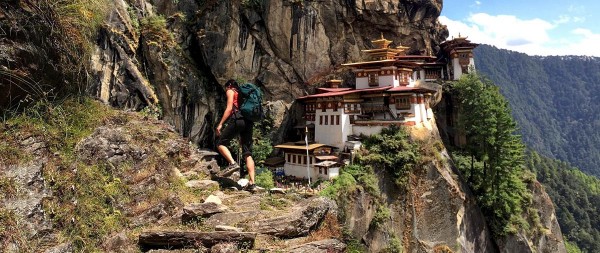Important Information
Region
Bhutan Tour
Duration
12 Days
Max Altitude 4900m
Best Season April - October
Activity Per Day
5-6 hrs
Grade
Level 4
Group Size
2 - 20 people
Transportation Flight - Car
Jomolhari Trek is the most demanding trek in Bhutan and probably one of the best treks in the world. Jomolhari (7,326 m) straddle on the border of Tibet Autonomous Region and Bhutan that source to Paro Chu River and Amo Chu River. It is a holy mountain for Buddhists and many pilgrimages from Pagri town of Tibet come to a holy lake of Jomo Lharang (5,100 meters) on the northern side. It is also known for the bride of Kanchenjunga. This trek also includes the landmarks of the Paro and Thimphu area.
This exhilarating Jomolhari trek will start from Paro and end in Thimphu. This trip starts with an acclimatization hike to Tiger Nest (Taktsang) in Paro. The first three days will be following the Paro Chu River en route to the remote villages of Paro of scattered farmhouses, paddy filed and orchids. From the base camp of Jangothang (4040 meters), you will see the close-up view of stunning Jomolhari. Besides that, you will have magnificent views of different mountains such as Jichu Drake (6989m) and Tshrim Gang (6789m). The trail gradually descends down toward Thimphu through vegetation and rocky canyons.
If you are looking for a Jomolhari trek and want to do it in a different itinerary please Customize your Trip. HWW’s travel advisor will assist you to create your Tour according to your time availability and interest.
Include
Accommodation: 3-star hotel in Thimphu and Paro.
7 nights in tented camp
Transportation during the trek.
Meals: All breakfasts, Lunches, and Dinners
Airport transfers on by private vehicle
Professional English speaking guide and necessary transportation.
All park entrance fees, trekking permits, and taxes
All Government Royalties
Sightseeing and site entry fees as listed
Exclude
International flights
Personal travel insurance, trekking gears.
Aerated & alcoholic drinks
Items of a personal nature such as phone calls, laundry, etc
Tips for guide and helpers.
Luxury hotels/resorts available on supplement cost
Specialized /language guides available on supplement cost
Travel / Medical Insurance
Important Information
* The Price given here is per person based on a minimum of 2 pax. The price will be cheaper with an increase in the number of people.
* If you are flying from Nepal then let us know we can help you to book your flight to Bhutan.
* Single Room Supplement is an extra charge.
Equipment
What to Bring for Trek?
Although trekking gear is available in Bhutan you are advised to bring your own gear.
- Footwear
- Trekking or running shoes
- Camp shoes or thongs
- Socks (polypropylene)
- Clothing
- Down or fiber-filled jacket
- Jumper or piled jacket
- Hiking shorts
- Waterproof jackets, poncho or umbrella
- Hiking pants
- T-shirts or blouses
- Underwear
- Sun hat
Other equipment
- Rucksack
- Self Inflating Sleeping Mattress (optional, “normal” mats provided by Bhutanese tour operators)
- Water bottle
- Torch, batteries, and bulbs
Useful Information
CHECKLISTS
- Valid passport (valid for six months from the date of your trip)
- One other picture ID, such as driver’s license (in case of emergency and for use as a substitute of passport or in case of loss of your passport) Photocopy of passport page to carry in a wallet
- Air tickets (Make a copy of flight tickets which may be helpful, in case of loss)
- Visa Clearance (Make a copy of visa clearance which may be helpful, in case of emergencies)
- MasterCard, Visa Credit and Debit Cards are accepted in Bhutan. However, traveler's cheques and some cash are highly recommended.
- Mobile (if your cell phone is from CINGULAR USA or ATNT (USA) operators then your cell phone will work in Bhutan.)
- Guiding, Food, and Camping
In Bhutan, all trekking supplies - camping equipment, kitchen implements, food - are all carried by pack animals. Porters are rather unusual in Bhutan with loads usually carted by horses or, in higher regions, yaks. All trekkers are accompanied by a guide, a cook, and usually at least one horseman or yak herder. With the surest footing; they lead trekking groups across the passes. The horseman and cook will usually run ahead during a trekking day. They will have prepared a packed lunch for hikers and will go on to the night’s resting place to set up camp.
They set up tents, cook dinner, and ready the area for arriving trekkers. When trekkers reach the campsite they are greeted with a hot cup of tea and biscuits in the dining tent. After six hours in the mountains, no drink will ever taste sweeter. For dinner, the cook will usually prepare a buffet of dishes that are as welcome as they are delicious.
DRESS CODE FOR VISITING FORTRESSES, MONASTERIES, AND TEMPLES IN BHUTAN
- Shirt (either half or full sleeve)
- Full pants/long skirts
- Any type of shoes with socks
- No Hats, No Umbrella, No Slippers, No t-shirts, No short skirt, and No half-pants
- Photographs allowed in the courtyard only.
Frequently Asked Question
| {{type.min}} - {{type.max}} Pax {{type.name}} - {{type.desc}} | {{type.display_price}} per people |
Extra prices:
Let us help you decide Inquiry
You might also like

- 7 days
- Bhutan Tour
Chele La Trek | 7 Days Bhutan Trek & Tour
Chele La trek is a short camping trek in the western region of Bhutan. This trek is perfect for those who want to experience trekking in Bhutan within a limited time span. Chele La trek offers you the panoramic view of Bhutan’s and eastern Nepal’s Himalayas such as Mount Jomolhari...



